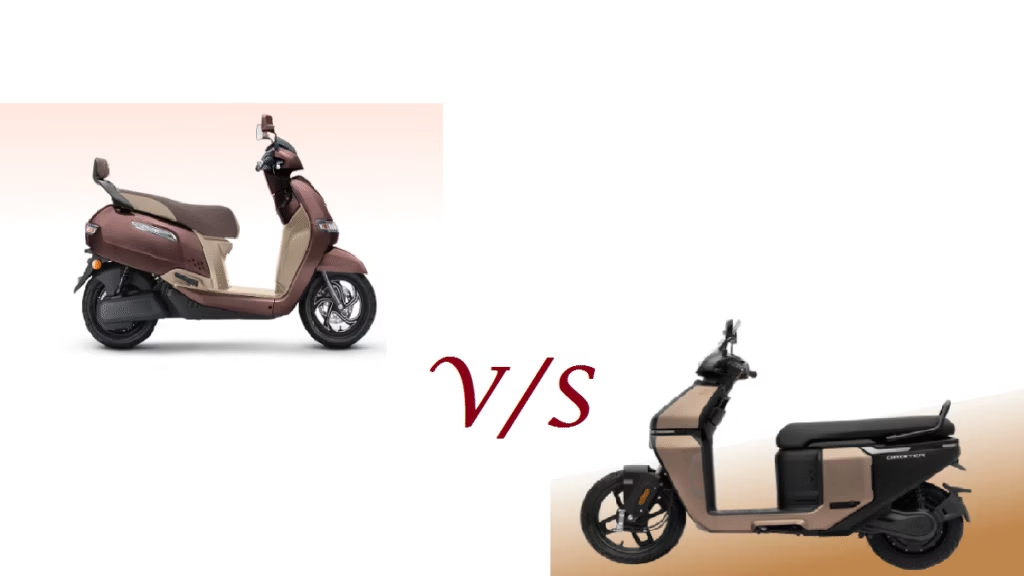New TVS Orbiter launched in 2025 with next-level cruise control features, more boot space, and an extra comfortable riding experience, comparison to new TVS Iqube models.

Comparison – TVS iQube vs TVS Orbiter
| Specification | TVS iQube (2025 Variants) | TVS Orbiter (2025) |
|---|---|---|
| Battery Capacity | 2.2 kWh (Base), 3.5 kWh (Mid), 5.3 kWh (ST Variant) | 3.1 kWh (Single Pack) |
| IDC (Claimed) Range | 75 km (2.2 kWh), 145 km (3.5 kWh), 212 km (5.3 kWh) | 158 km |
| Real-World Range | 60 km (Base), 110 km (Mid), 170 km (ST Variant) | 100 km |
| Top Speed | 75–78 km/h (Base & Mid) 82 km/h (ST Variant) | 68 km/h |
| Motor Power | 4.4 kW Hub Motor | 3.5 kW Motor |
| Charging Time (0–80%) | 2 h 45 min (2.2 kWh), 4 h (3.5 kWh), 4 h 15 min (5.3 kWh) | 4 h with 650W charger (full charge 6 h) |
| Display & Controls | 5″ TFT / 7″ TFT (ST Variant), SmartXonnect, Navigation, OTA Updates | Digital LCD Cluster, Connected Features, Cruise Control |
| Unique Features | Regenerative braking, Q-Park Assist, GPS navigation, OTA support, Tyre Pressure Monitoring (ST) | Cruise control, Hill-hold assist, 34 litre boot, Geo-fencing, OTA updates |
| Price (Ex-Showroom) | ₹1.02 L – ₹1.60 L depending on variant | ₹99,900 |
| Launch Status | Available across India (updated 2025 line-up) | Launched in Aug 2025, bookings open |
Performance And Range –
The TVS iQube 2025 is designed for riders seeking enhanced power, range, and modern features for their daily commutes. It now offers upgraded battery options, including a robust 5.3 kWh pack that provides up to 212 km on a single charge. In real-world conditions, it comfortably delivers a range of 120 to 145 km, making it perfect for long rides or heavy daily usage.
With a powerful 4.4 kW motor, the iQube reaches a top speed of approximately 80 km/h and can accelerate from 0 to 40 km/h in just over 4 seconds. Additionally, features such as regenerative braking, multiple riding modes, a TFT display, navigation, and smart connectivity make it a technologically advanced and performance-oriented scooter.
The TVS Orbiter, launched in 2025, is a budget-friendly and practical option for riders. It features a 3.1 kWh battery with an IDC-certified range of 158 km, which translates to approximately 100 km in real-world riding conditions. The bike is powered by a 2.5 kW hub motor, achieving a modest top speed of around 68 km/h and taking 6.8 seconds to accelerate to 40 km/h.
While the Orbiter may not match the performance of the iQube, it excels in everyday usability with features like cruise control, hill-hold assist, larger 14-inch front wheels, a spacious boot, and comfortable seating. This makes the Orbiter an excellent choice for urban riders seeking a reliable and affordable electric vehicle for daily commutes.
GST Benefits
Earlier, electric scooters in India were taxed at 12% GST, which made them slightly expensive for buyers. Under the new GST slab, the rate has been reduced to just 5% comparison to old GST slab, making EVs more affordable. This change directly lowers the on-road price of electric scooters, encouraging more people to shift towards eco-friendly transportation.